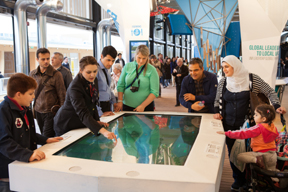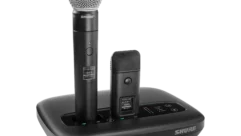
SVC Podcast – Show Notes – Show 138-2:
In this edition of the SVC Podcast, SVC Contributing Editor Bennett Liles continues his talk with Steve Hass, President of SH Acoustics, about a very challenging sound system installation for the U.S. pavilion at Expo Milano Milan, Italy. Steve provides details on how a “source to amplifier” site-wide Dante media network was set up and he explains how the SymNet Composer software is used to configure the SymNet Radius DSP units.
Links of interest:
- SymNet DSP products used to control sound at the U.S. pavilion
- Stewart Audio amplifiers used on the project
- Innovox Audio, home of the custom designed speakers installed by SH Acoustics
Download Podcast Here:
https://s3.amazonaws.com/nb-svc/public/public/138-2_Expo_Milano_SH_Acous…
From Sound & Video Contractor Magazine, this is the SVC Podcast with Steve Haas of SH Acoustics. Show notes for the podcast are available on the web site of Sound & Video Contractor Magazine at svconline.com.
The U.S. Pavilion at Expo Milano in Milan, Italy has plenty of steel and glass. That presented a big challenge for SH Acoustics. They had the job of installing a sound system with multiple zones and sources. Company president Steve Haas is back with us to wrap up the details on how he used SymNet DSPs to get the sound under control. That’s up next on the SVC Podcast.
Steve, thanks for getting back with us for the SVC Podcast from SH Acoustics in Milford, Connecticut. We were talking about the sound system in the U.S. pavilion at Expo Milano, the World’s Fair going on in Milan, Italy. I think you made use of a site-wide Dante media network. Describe that for us.
Thank you very much, Bennett. Glad to be back here. So yes, this was the first project that we have implemented Dante from the source to the amplifier and so we’re very happy with the way that turned out. One of the main reasons why we chose this to be our experiment with Dante is simply because number one, the Symetrix brand, we have been hearing a lot about how they’ve implemented with other equipment, other amplifiers and source equipment. So it was really motivating knowing that we had their support on utilizing Dante and help with the network design, but also the fact that again, with this particular project we knew everything was going to come to a crunch. And being able to find ways to effectively connect the system together in as easy of a way and the least time possible proved to be very valuable. And then certainly the Dante network, its reliability as well, was absolutely needed given all of the unknowns and all of the difficult conditions that we were dealing with in this particular site and then project. [Timestamp: 2:26]
In Part 1 you mentioned acoustic treatment as being part of this. The main hallway looks to me as though it must have been very reverberant. Was there acoustic treatment done in that area before you got into the electronics of it?
Yes. I believe you’re talking about the upper boardwalk area.
Yes.
There are two main areas. There was this more – we’ll call it the black box lower space called the Foodscape, which had the very intense multimedia programs. And that was heavily treated, both the ceilings and the walls in addition to the audio delivery techniques and we designed to really achieve incredible control over the space itself including angled barriers. But the boardwalk above was a much more open space and it did not have global treatment because it was pretty much exposed to the outside. We could have used weather-proof type of treatment, but we chose not to because of the nature of that area being quite open on one side where you see all the plants and the food growing on the one side. And plus the experiences – the media experiences – were more localized and contained. So again we did a lot with audio delivery, but not so much on the upper level with acoustic treatment. That was more reserved for the big media experience on the lower level. [Timestamp: 3:49]
I’m sure there was a lot to handle in coordinating sources on this thing. What are the various sound sources that can be used? What did you have to contend with on the inputs?
On the inputs they were mostly customized video servers and audio playback servers that the exhibits AV integrator, Simmetrico – not to be confused with Symetrix – out of Italy, are known over there for being able to create their own customized delivery sources, and that’s exactly what they did for all the videos. Now some of the smaller media, I believe, had Alcorn McBride players, multichannel audio players, where they didn’t need a significant video server associated with it; it was more of a soundscape type of activity such as walking up the big ramp, which was quite interesting. That ramp was made up of remnants of the only Coney Island boardwalk and we had to integrate speakers in the steps of the ramp to be able to deliver sound continuously because the architects didn’t want to see those speakers anywhere, which is not common. [Timestamp: 5:00]
Wow. And from the pictures it looks like there are a lot of exposed beams and open spaces. I know that would present some problems acoustically but it could also make things more difficult in running power and speaker lines.
Oh definitely, it did. And what was the bigger challenge was that again, as I mentioned in Part 1, the building was still being built on top of when the exhibits were going in and the AV was being installed. So normally there are actually structures finished to run your cable through. In this case the AV integrators had to be very careful not to, one, wiring too early or even the speakers, just as I mentioned in the steps, in the treads. Those were still being built when I got there to calibrate the system. So it wasn’t exactly ready to go. [Timestamp: 5:49]
Yeah, I can imagine that and it’s inevitable on something that big to have people sort of getting in each other’s way. I noticed that you used amplifiers from Stewart Audio and Yamaha. How did you use those?
In two different ways. The Yamaha were the 8-channel Dante-enabled amps and the Stewarts were the individual smaller-format half-rack amplifiers, or maybe even third-rack amplifiers. The reason that went with two different platforms is because some of the exhibits, we were able to put the amplifiers in the racks where others we actually had to locate the amplifiers very close, such as in touch tables or other interactive tables where we just didn’t want to have to run speaker wire all the way hundreds of feet to these particular locations. So we chose to keep, again, the Dante network active all the way up to a locally-installed amplifier; in this case the Stewart amplifier. So that was the big difference in why we chose two different amplifier brands. [Timestamp: 6:52]
And in locating the racks and equipment I would think that you have to balance security with the length of cable runs and with just where they will let you get things in.
Exactly. I can’t speak particularly about all the challenges that the integrators had with cable runs, but again, based on the schedule and how far the building was behind when they were installing, I know that they had a lot of difficulty and did a lot of things that perhaps weren’t necessarily great standard practices, by AV integrator terms, but nonetheless necessary to actually get the job wired and the speakers and other equipment in where it needed to be in time. [Timestamp: 7:43]
And they’re still installing the electrical system while your guys are working in there. Were there any surprises as far as ground loops or anything like that?
Yeah. I mean at least they were testing the electrical and that’s why it was going on and off at times, but there were definitely the power issues that were intermittent and certainly network issues going down where we were not able to connect. And that was throughout the expo; that was not just local to the pavilion. It was just a very difficult time where equipment needed to talk with itself but also with outside networking or outside internet and networking. It was just a very challenging site. But not too many grounding issues, surprisingly. Everything seemed to be well-behaved once it actually got turned on and installed completely. [Timestamp: 8:23]
And in Part 1 we were talking about the Symetrix DSP. You set that up with the SymNet Composer software. What’s the learning curve there? How quickly can you get up to speed on that?
Well I think that is one of the main reasons why we like the SymNet platform, the Symetrix platform, as well because the learning curve on the Composer is, I would say, above average to very good simply because it’s just intuitive. Some of the platforms that we’ve used in the past just do not have, especially on the programming side, an intuitive ability to set up functionality and programming blocks and their DSP blocks and such. So we just find that SymNet is not the only easy-to-learn program, but it certainly is one of our preferred ones for that very reason. [Timestamp: 9:13]
And that’s been a key thing for Symetrix because even with great hardware if it’s a pain to work with and to set up with the software, there are going to be mistakes made and it’s really going to hurt the whole product.
Mm-hm. Exactly.
So were there various presets that you had configured on the DSPs?
Yes, used in a very particular way for what we call global volume control. In that, I mean this is probably one of the best examples of why this is necessary that we put this on almost every project is because there were times or are times during this pavilion operation where there might be a couple dozen people, but then there are times where there are literally a thousand or more people every hour or two trying to cram their way through this. So certainly the ambient noise level changes dramatically. Even if we have all the relative volumes perfectly balanced we can’t rely on just one absolute volume level. We need a way to be able to raise and lower that very easily for a non-technical operator to do based on the ebb and flow of visitors to the pavilion. [Timestamp: 10:22]
That’s got to be hard to simulate, just how raucous a crowd that you may have in there at times.
Exactly, because I mean even with a particular quantity of people, some of those people can be very quiet. And especially since this is a global attraction, some groups may be very reverent and respectful, and other groups might be incredibly raucous, as you said. So it’s not even a quantity, it’s more of just an evaluation of how much ambient crowd noise there is at any given time. [Timestamp: 10:52]
You never know for sure what you’re going to get on that but you got it done and it’s still over there cooking along every day. What have you got coming up next? Got things in the project pipeline right now?
Sure. We have a lot of major museums on the east coast; The Smithsonian National Museum of African American History and Culture. And on the west coast we have the California Science Center’s Air and Space Center, a project that’s being personally run by our Los Angeles office that we opened two years ago. We have some exciting things coming up. [Timestamp: 11:25]
All right. It sounds like it and this has been a very interesting one. I know it was a big job but with your experience in just that type of thing it might have actually been kind of fun in hindsight to have stretched your muscles on this one. It’s Steve Haas, president of SH Acoustics with the U.S. pavilion at Expo Milano. Thanks for giving is all the details, Steve.
You’re welcome, Bennett.
Thank you for being here with us for the SVC Podcast with Steve Haas. Show notes are available on the website of Sound & Video Contractor Magazine at svconline.com. Be back with us for the next SVC Podcast.










